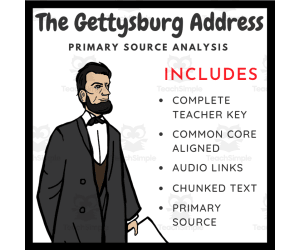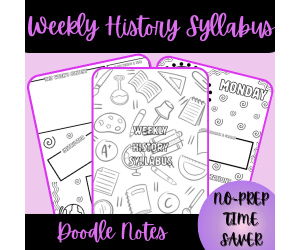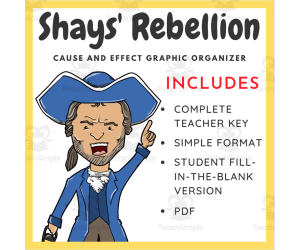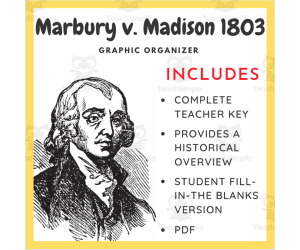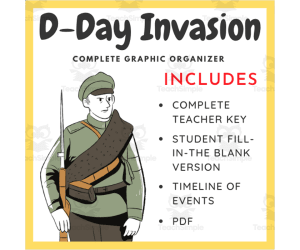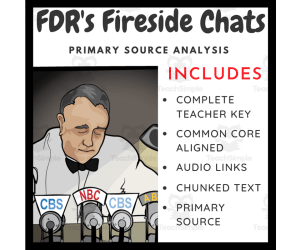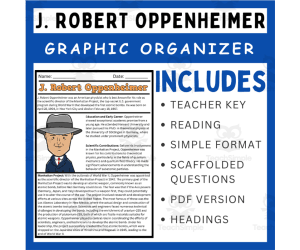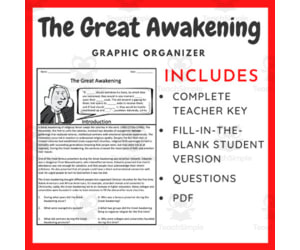2,762 products added recently
History Graphic Organizers
Deepen students' grasp of historical concepts by integrating graphic organizers specific to social studies. This collection includes timelines, event mapping, and comparison charts. By using these tools, you can help students organize complex information and draw meaningful connections.
The Gettysburg Address: Primary Source Analysis
Social Studies, History, History: USA, Grade 7, 8, 9, 10, 11, Teacher Tools, Graphic Organizers
In November of 1863, a ceremony was held to dedicate a cemetery in Gettysburg to honor the great battle. The first speaker was Edward Everett, who gave an impassioned two-hour speech. After Everett, Abraham Lincoln rose and spoke for little more than two minutes. Lincoln’s Gettysburg Address was, in many ways, a summation of why the war was being fought and the meaning of the sacrifices made by the men who fought in the battle. At the end of Lincoln’s speech, Edward Everett, the man who had spoken prior to Lincoln, said, “I wish I could flatter myself that I had come as near to the central idea of the occasion in two hours as you did in two minutes." This product will help bring the speech alive to your students. This product is aligned to excerpts read directly from the speech. Excellent for struggling readers and audio learners. This product breaks down the speech into chunked text for students. After each section, students are asked some simple processing questions that will help them comprehend what they have read. I have also include time stamps so that students can listen to the speech while they follow along. Clipart and Product Clipart Credit: by Dandy Doodles
Author EduPal Learning
Tags Gettysburg Address, Lincoln, CIvil War, Primary Source , Common Core, Gettysburg Address Analysis, Analyze The Gettysburg Address, Primary Source Battle Of Gettysburg, Gettysburg Address Worksheet Pdf, Gettysburg Primary Source, The Gettysburg Address Analysis, Analyze Gettysburg Address, Analysis Of Gettysburg Address, Central Idea Of The Gettysburg Address, Gettysburg Address Worksheet, Analysis Of The Gettysburg Address
The Antebellum South: Graphic Organizer
Social Studies, History, History: USA, Grade 7, 8, 9, 10, Teacher Tools, Graphic Organizers
The Antebellum South: Graphic Organizer The Antebellum South: Graphic Organizer is a vital teaching resource designed to aid educators in imparting students with an intuitive understanding of the complex societal, economic, and cultural facets of the pre-Civil War era in the Southern United States. This tool proves particularly beneficial for Grade 7 to Grade 10 educators dealing with social studies. Key Features: Insightful Understanding: Alongside explaining topics like slavery and socio-economic division prevalent in the antebellum south, this resource also provides insights into cotton and tobacco - cash crops extensively farmed on plantation farms using enslaved Africans. All-encompassing narrative: This graphic organizer weaves together crucial events such as Nat Turner's rebellion while tracing debates sparked by southern leaders justifying slavery based on economic compulsions which simultaneously raised discussions around racial hierarchy and states' rights.(Refer to appended teacher notes) Versatility: Suitable for whole-class discussions, group activities or assigned as individual research work due to its self-explanatory design. Tailored Resources: Presented in PDF format, The Antebellum South: Graphic Organizer includes both a teacher-prepared notes variant complete with comprehensive explanations and a student variant that promotes self-learning. Note:The uniqueness lies in this tool's succinct yet informative approach – allowing grades 7-10 students to effectively grasp historical contexts without compromising on factual integrity solely aimed at enhancing their educational pursuits. As an added bonus, thumbnail clipart supplied by Clip Art Emporium makes it visually engaging. Not requiring additional software or resources adds icing on the cake – just print it out and you're all set! Encoded with rich education values, this ready-to-use tool indisputably becomes a wonderful addition to any classroom.
Author EduPal Learning
Tags Antebellum South, Graphic Organizer, Social Studies, Slavery, Plantation Farms
Cold War Overview: Graphic Organizer
Social Studies, History, History: Europe, History: World, Grade 7, 8, 9, 10, 11, Teacher Tools, Graphic Organizers
The Cold War was a time of tension and rivalry between the United States and the Soviet Union that lasted from the end of World War II in 1945 until 1991. The two superpowers never fought a direct war against each other, but they were involved in many proxy wars, such as the Korean War and the Vietnam War. The Cold War started because the United States and the Soviet Union had different ideas about how countries should be run. The United States believed in democracy, where the people elect their leaders and have individual freedoms. The Soviet Union believed in communism, where the government controls everything and everyone is equal. The United States and the Soviet Union both wanted to spread their ideas and influence around the world, which led to a lot of tension between them. They also built up huge military forces, including nuclear weapons, to try to scare each other into backing down. The most dangerous time during the Cold War was in 1962, during the Cuban Missile Crisis. The Soviet Union had secretly put nuclear missiles in Cuba, which is very close to the United States. The United States demanded that the missiles be removed, and there was a tense standoff between the two superpowers. Eventually, the Soviet Union agreed to remove the missiles, and the crisis was over. The Cold War ended in 1991 when the Soviet Union collapsed. The United States emerged as the world's only superpower, and there was a lot of hope for peace and cooperation between countries. While there are still tensions between countries today, the world is much more peaceful than it was during the Cold War. Teacher-prepared notes show students what is important and how ideas relate, and offer a model for how students should take notes themselves (Marzano et al., 2001). These teacher-created notes will help your students grasp the major events of the Cold War era. These notes work well as a supplement to class readings! Thumbnail and product clipart credit: By PrincePadania and byDandy Doodles This product provides students with an easy-to-understand overview of the major issues, leaders, and events associated with the Cold War.
Author EduPal Learning
Tags Cold War, Stalin, Graphic Organizer, High Yield Strategy
Reconstruction 1865-1877 - Two Graphic Organizers
Social Studies, History, History: USA, Grade 8, 9, 10, 11, Teacher Tools, Graphic Organizers
Reconstruction 1865-1877 - Two Graphic Organizers This teaching resource delves into the critical period in American history that followed the Civil War. A valuable tool for educators of Grades 8 through 11, it provides comprehensive content on a complex epoch concerning History or Social Studies related to USA. Main Focus: The resource focuses majorly on Reconstruction protocols post-Civil War and outlines political, social, and economic shifts during this tenure. The primary objective was re-establishing Southern states which had seceded from the Union and integrating African Americans into society. Legislation Elements: 13th to 15th Amendments: Abolished slavery while providing citizenship rights to African Americans. Freedmen's Bureau Policy: Safeguarded interests of those recently freed from enslavement. Dual Graphics Organizers Feature: Packed with valuable information integrating politics within Postwar Reconstruction in South alongside a map highlighting Southern military districts—understanding how Southern states were readmitted post-war handling of issues regarding African American integration and determining controlling parties over Reconstruction. Challenges Faced: Resistance from opposing white Southerners. A rise in clans promoting racial segregation due to societal strains. Fraudulent methods used by white democrats regaining control leading up to Jim Crow era commencing racial segregation till Civil Rights Movement took charge later in mid-20th century. In addition, teacher-prepared notes help streamline complex narratives for students while boosting their note-taking skills (Marzano et al., 2001). Flexibility in Teaching Approach: With multiple file types, including teacher versions and student fill-in-the-blank ones paired with illustrative clipart (credit: Prince Padania), this resource provides flexibility for educators – suitable for large group discussions, small clusters, or homework assignments.
Author EduPal Learning
Tags Reconstruction, Civil War Aftermath, African American Integration, Legislative Changes, Social Challenges
LBJ's Great Society: Graphic Organizer
Social Studies, History, History: USA, Grade 7, 8, 9, 10, 11, Teacher Tools, Graphic Organizers
The Great Society program was a set of domestic policies and initiatives introduced by President Lyndon B. Johnson in the 1960s. It aimed to address various social issues and create a more equitable society in the United States. The Great Society encompassed a wide range of programs and legislation focused on areas such as civil rights, poverty alleviation, education, healthcare, and urban renewal. The Great Society program had a significant impact on American society, particularly in terms of civil rights, poverty reduction, and access to education and healthcare. However, its implementation faced challenges, and its long-term effects have been the subject of ongoing debate and evaluation. Teacher-prepared notes show students what is important and how ideas relate, and offer a model for how students should take notes themselves (Marzano et al., 2001). These notes begin by giving students an overview into the events that led to LBJ's presidency. The notes then broadly categorize the two major goals of The Great Society and provide four legislative achievements for each one. This graphic organizer will work great as an introduction to the Great Society! Comes with a student fill-in-the-blanks sheet. Ready to use! Thumbnail clipart credit: By PrincePadania
Author EduPal Learning
Tags LBJ, Great Society, 1960s, APUSH, US History, Graphic Organizer, Scaffolded Learning
Weekly History Syllabus Doodle Notes
Creative Arts, Graphic Arts, ELA, Writing, Resources for Teachers, History, Social Studies, High School, Homeschool Resources, Middle School, Worksheets & Printables, Writing Prompts, Teacher Tools, Graphic Organizers, Outlines, Templates
Ever feel like your history lessons need a serious pick-me-up? After watching my teenager's eyes glaze over during one too many timeline activities, I knew I had to create something different! These Weekly History Syllabus Doodle Notes were born late one night at my kitchen table, surrounded by scattered history books and half-finished lesson plans that weren't working for either of us. As a fellow homeschool mom who's navigated the treacherous waters of teaching history to a teenager (who'd rather be doing ANYTHING else), I have poured all my real-world experience into these templates. Gone are the days of dry, boring history planning that puts both of us to sleep! Instead, I have created visual planning sheets that finally clicked for my visually-oriented teen. Now we're mapping out historical connections, documenting primary source readings, and planning research activities in a way that actually sticks! The magic happens when those historical concepts come alive through both organized planning AND creative visual elements. My daughter went from "Do we have to do history today?" to pointing out connections between historical periods on her own—I amnot kidding! These templates have completely transformed how history works in our homeschool, and I cannot wait for them to do the same for yours. INCLUDED IN THIS RESOURCE: Comprehensive weekly history planning template with visually engaging design Designated spaces for historical learning objectives, content focus, and instructor information Daily sections for documenting classwork, discussions, quizzes, and attendance Specialized reading assignment sections for historical texts and primary sources Homework planning areas with website research recommendations and writing prompts Visual note-taking spaces that connect historical concepts with creative representation Structured organization that accommodates the unique narrative nature of history instruction Look, I am not going to pretend I'm some super-organized homeschool mom with color-coded bookshelves (my laundry pile would quickly disprove that myth!). But after years of history lessons that felt like pulling teeth, these doodle notes have honestly saved our homeschool history curriculum. Sunday afternoons used to find me stressed and overwhelmed, staring at history books and wondering how to make centuries-old events relevant to my tech-obsessed teen. Now? I actually look forward to mapping out our history week! The combination of chronological organization with visual creativity means concepts stick in a way they never did before. My daughter has gone from glazed-over eyes to making connections between historical periods on her own. No joke—last week she compared political patterns from ancient Rome to something in today's news WITHOUT PROMPTING! Grab these templates today, and in a few weeks, you will be texting your homeschool friends about how your kid suddenly loves history. (And they'll demand to know your secret!) If you and your students/homeschoolers enjoyed this resources, please leave a review. Thank you for your support! Tina - Big Easy Homeschooling Mom Please subscribe: tidewindacademyhomeschool.com
Author Homeschool with Big Easy Homeschooling Mom
Rating
Tags History Doodle Notes, Visual Aids, Visual Learning Tools, Social Studies Planning, History Syllabus Templates, Doodle Notes, Homeschool History Organization, Homeschool Social Studies Organization Tools, Weekly History Planning Templates For Homeschoolers, Educational Organization
Progressive Era Muckrakers Reading & Graphic Organizer
Social Studies, History, History: USA, Grade 6, 7, 8, 9, 10, 11, 12, Teacher Tools, Graphic Organizers
This is a set of readings on the leading "muckrakers" of the Progressive Era. This resource includes a corresponding graphic organizer . I suggest to finish the lesson with an excerpt from Upton Sinclair’s The Jungle—a big hit with the high school set.
Author Exa's Excellent Social Studies Lessons
Tags Progressive Era, Muckrakers, The Jungle, Ida Tarbell, Theodore Roosevelt, Progressive Era Muckrakers Answer Key, Progressive Era Muckrakers Worksheet Answers, Modern Day Muckrakers
The Korean War 1950-1953: Graphic Organizer
Social Studies, History, History: Asian, History: USA, History: World, Grade 7, 8, 9, 10, 11, Teacher Tools, Graphic Organizers
The Korean War 1950-1953: Graphic Organizer This top-tier, educationally charged resource goes beyond just delivering the what and when of events. Rather it provides students a vivid understanding of how history unfolded. Specifically tailored for Grade 7 to Grade 11 social studies instruction. Carefully crafted four-paged overview outlining key events and influential figures from the Korean War era. Fills in an essential component in Asian, USA and World History subtopics. Developed with insights from Marzano et al.'s research compounded educational methodology background, . This ensures an effective mapping of relationships between various historical events instances thereby fostering comprehensive understanding among learners. Doubles as a demonstration of effective note-taking strategy for visual learners thanks to its meticulous design approach. Incorporates illustrative drawings from Illustration Station, adding visual interest and aiding content comprehension. This flexible teaching toolkit can be used across a variety of classroom scenarios: small group tasks, individual assignments or even as homework material. An included answer key ensures the educator is ever ready for spontaneous discussions within sessions. And all this comes in an editable PDF format that can smoothly become part of your digital or print classroom resources! The Korean War 1950-1953: Graphic Organizer - Your reliable companion facilitating every social studies lesson to transform into enlightening journey through time!.
Author EduPal Learning
Tags Korean War, Cold War, Asian History, USA History, World History, Korean War Clipart
The Scientific Revolution: Graphic Organizer
Social Studies, History, History: World, Grade 7, 8, 9, 10, 11, Teacher Tools, Graphic Organizers
The Scientific Revolution refers to a period of profound scientific advancements and changes in the way people viewed and understood the natural world. It took place roughly between the 16th and 18th centuries, starting with the Copernican Revolution and ending with the Enlightenment. During this period, several significant scientific discoveries and advancements were made, leading to a fundamental shift in scientific thinking. Some key figures associated with the Scientific Revolution include Nicolaus Copernicus, Galileo Galilei, Johannes Kepler, Isaac Newton, and Francis Bacon. One of the central developments of the Scientific Revolution was the heliocentric model of the solar system proposed by Copernicus. He argued that the Earth revolves around the Sun, challenging the prevailing geocentric model that placed the Earth at the center of the universe. Galileo's observations with his improved telescope supported Copernicus' heliocentric model and further contributed to the understanding of planetary motion. Galileo also conducted experiments on motion, discovering the principle of inertia and making significant contributions to the field of mechanics. Johannes Kepler formulated three laws of planetary motion, providing mathematical descriptions of how planets move in elliptical orbits around the Sun. His laws helped establish a more accurate understanding of celestial mechanics. Perhaps the most influential figure of the Scientific Revolution was Sir Isaac Newton. His groundbreaking work in physics, laid out in his book "Mathematical Principles of Natural Philosophy" (often referred to as "Principia"), presented the laws of motion and the law of universal gravitation. Newton's laws provided a unified framework for understanding the motion of celestial bodies and objects on Earth. The Scientific Revolution also saw advancements in other fields, including anatomy, biology, chemistry, and optics. It led to the development of new experimental methods and the establishment of scientific institutions, such as the Royal Society in England. The impact of the Scientific Revolution extended beyond the scientific realm. It challenged long-held beliefs and traditional authorities, particularly those of the Catholic Church. The new scientific knowledge and methods encouraged critical thinking and the pursuit of empirical evidence, laying the groundwork for the Enlightenment—an intellectual and philosophical movement that emphasized reason, individualism, and progress. Overall, the Scientific Revolution marked a significant turning point in human history, ushering in a new era of scientific inquiry, experimentation, and a more systematic approach to understanding the natural world. It paved the way for subsequent scientific advancements and continues to shape our understanding of the universe today. Teacher-prepared notes show students what is important and how ideas relate, and offer a model for how students should take notes themselves (Marzano et al., 2001). These notes come with a completed teacher version and a student fill-in-the-blank version. Ready to print and ready to use! Works great with the interactive notebook! Thumbnail Clipart Credit: By PrincePadania
Author EduPal Learning
Tags Scientific Revolution, Graphic Organizer , Galileo, Newton, Copernicus
People to Know - World History I Matching Sets
Social Studies, History, History: World, Grade 9, 10, 11, 12, Teacher Tools, Graphic Organizers
If your history students are studying important people in history, this is a great resource that will help students organize their thoughts, take notes, and review their learning in engaging ways. This is aPeople to Know World History I Matching Sets. This was designed for your high school history students. It is broken down into 4 different sections: --Greeks & Romans --Asians --People Groups --Others There are 22 terms for students to choose from. Some of the terms included are: --Humanists --Socrates --Vikings --Mongos --Julius Caesar --Socrates --Caesar Augustus --Genghis Khan --Asoka --Hammurabi You may choose to use these matching sets in many different ways. You can have students cut everything out and paste the correct name to the correct description. They can use the matching sets for independent review. If you want to increase engagement, they can also work with a partner to quiz one another. I hope you enjoy! Take A Look at My Best Sellers: Reformation Book Cover World History II Remediation Packet Modern World People Foldable The World in 1500 AD Cheat Sheet Explorer Project Genocide Worksheet You can find more resources at my storefront here: https://teachsimple.com/contributor/history-with-delong
Author History with DeLong
Tags World History I Worksheet, Matching Sets, People To Know, Historical Leaders, Graphic Organizer, Social Studies Definitions, Review
Shays' Rebellion: Cause and Effect Graphic Organizer
Social Studies, History, History: USA, Grade 7, 8, 9, 10, Teacher Tools, Graphic Organizers
Shays' Rebellion was primarily caused by a combination of economic and political factors that created discontent and frustration among farmers and debtors in Massachusetts. These factors combined to create a sense of frustration, economic hardship, and perceived injustice among the farmers and debtors in Massachusetts. Shays' Rebellion was their response to these challenges and their attempt to address their grievances against the state government and the economic system. Overall, Shays' Rebellion had far-reaching effects on the United States. It played a pivotal role in shaping the movement towards a stronger federal government, the ratification of the Constitution, and the protection of individual rights. It also brought attention to economic grievances and contributed to discussions on economic policies. Teacher-prepared notes show students what is important and how ideas relate, and offer a model for how students should take notes themselves (Marzano et al., 2001). These teacher-created notes will help your students grasp the major causes and effects of Shays' Rebellion in 1786. The notes come with a student version and a completed teacher version. These notes work well as a supplement to class readings! Thumbnail clipart credit: By Prince Padania (highly recommended). For similar resources and other engaging ones, visit my store here!
Author EduPal Learning
Tags Shays' Rebellion, US History, U.S. History, American History, Graphic Organizer , Shays Rebellion Effects, Result Of Shays Rebellion, What Were The Causes Of Shays Rebellion, Shays Rebellion Cause, What Caused Shays' Rebellion, What Caused The Shays Rebellion, What Was The Result Of Shays Rebellion, Shays Rebellion Causes
Truman and the Dropping of the Atomic Bomb: Graphic Organizer
Social Studies, History, History: USA, Grade 8, 9, 10, 11, Teacher Tools, Graphic Organizers
Harry S. Truman, the 33rd President of the United States, played a pivotal role in the development and use of atomic bombs during World War II. Truman assumed the presidency on April 12, 1945, following the death of President Franklin D. Roosevelt. At that time, the Manhattan Project , a secret research program focused on developing atomic weapons, was already underway. As President, Truman was faced with a difficult decision regarding the use of atomic bombs against Japan. The Manhattan Project had successfully created two atomic bombs, and Truman had to decide whether to deploy them as a means to end the war. After the war, Truman focused on preventing the spread of nuclear weapons. He supported the creation of the United Nations and played a key role in establishing the Baruch Plan, which proposed international control of atomic energy to prevent further proliferation. Truman's decision to use atomic bombs on Hiroshima and Nagasaki remains one of the most consequential actions of his presidency. It ushered in the nuclear age, shaped the course of history, and sparked ongoing discussions about the use and ethics of atomic weapons. Teacher-prepared notes show students what is important and how ideas relate, and offer a model for how students should take notes themselves (Marzano et al., 2001). This graphic organizer gives students two primary source quotes regarding Truman's use of the bomb. The notes then explain some pro/con arguments about the use of the bomb. Lastly, the notes give students a chance to look at the six immediate effects of the bomb. Comes with a fill-in-the-blank version. Clipart Credit: By PrincePadania
Author EduPal Learning
Tags World War II, Truman, Atomic Bomb, Manhattan Project, Japan, Cold War, Graphic Organizer, Pro Con Graphic Organizer
Marbury v. Madison 1803: Case Brief
Social Studies, History, History: USA, Government, Grade 9, 10, 11, 12, Teacher Tools, Graphic Organizers
Marbury v. Madison was a landmark case in United States Supreme Court history, decided in 1803. It established the principle of judicial review, which is the power of the federal courts to declare a law or government action unconstitutional. The case arose when William Marbury, a Federalist, sued Secretary of State James Madison for not delivering his commission as a justice of the peace. Marbury argued that the Judiciary Act of 1789 gave the Supreme Court the power to issue writs of mandamus compelling executive officials to perform their duties, and that he was entitled to such a writ. However, Chief Justice John Marshall ruled that the Judiciary Act of 1789 was unconstitutional, because it attempted to give the Supreme Court powers that were not granted to it by the Constitution. Marshall reasoned that the Constitution established a system of checks and balances between the three branches of government, and that the power of judicial review was inherent in the Constitution. Marshall's ruling established the principle of judicial review, which has since become a fundamental principle of American constitutional law. The ruling also strengthened the power of the federal judiciary relative to the other branches of government, and established the Supreme Court as the final arbiter of the Constitution. Teacher-prepared notes show students what is important and how ideas relate, and offer a model for how students should take notes themselves (Marzano et al., 2001). These teacher-created notes will help your students grasp the major impact of the Marbury v. Madison 1803 case. These notes come with a student version and a completed teacher version. These notes work well as a supplement to class readings! Product clipart credit: byPrince Padania
Author EduPal Learning
Tags James Madison, Marbury, 1803, US History, Case Brief, Judicial Review, History, Marbury V Madison Case Brief, Facts About Marbury V.madison Case, Marbury V. Madison (1803) Case Brief, Marbury Vs Madison Case Facts, Marbury Vs Madison Brief, Marbury V. Madison Brief, Case Brief For Marbury V Madison, Marbury Vs. Madison Case Brief, Marbury Vs. Madison History Video, The Supreme Court Case Of Marbury V. Madison (1803) Established The Principle Of, Madison Vs Marbury Short Summary
New Deal Alphabet Agencies: Graphic Organizer
Social Studies, History, History: USA, Grade 7, 8, 9, 10, 11, Teacher Tools, Graphic Organizers
The New Deal was a series of economic programs and reforms implemented in the United States during the 1930s by President Franklin D. Roosevelt (FDR). It was a response to the severe economic crisis of the Great Depression, which began with the stock market crash in 1929. The New Deal aimed to address the widespread unemployment, poverty, and economic instability that plagued the country. Its primary goals were relief for the unemployed and those in need, economic recovery, and reform to prevent future economic crises. The New Deal consisted of three main components, often referred to as the "Three Rs": Relief, Recovery, and Reform. Overall, FDR's New Deal represented a significant expansion of the federal government's role in the economy and social welfare, aiming to provide relief to those in need, stimulate economic recovery, and establish long-term reforms to prevent future economic crises. Teacher-prepared notes show students what is important and how ideas relate, and offer a model for how students should take notes themselves (Marzano et al., 2001). This fill-in-the-blank graphic organizer is perfect for your student's interactive notebook. It looks at the 3 R's of the New Deal (Relief, Recovery, and Reform), and provides examples of agencies that aimed to fulfill those goals. Ready to use - no prep.
Author EduPal Learning
Tags New Deal, FDR, US History, Great Depression, Franklin Roosevelt, Deficit Spending , Graphic Organizer, Alphabet Agencies New Deal, What Were The Alphabet Agencies
Modern Era's Important People Graphic Organizer
Social Studies, History, History: World, Grade 9, 10, 11, 12, Teacher Tools, Graphic Organizers
This is a Modern Era's Important People Graphic Organizer . This can be printed or completed digitally. Students will: - Look them up - Tell what they did - Tell what they are known for - Name and color their country on the map There are 14 people. Answer key included.
Author History with DeLong
Tags Modern Era, Geography, World History, Graphic Organizer, Gandhi
D-Day Invasion: Graphic Organizer
Social Studies, History, History: USA, History: World, Grade 7, 8, 9, 10, 11, Teacher Tools, Graphic Organizers
The D-Day Invasion: Graphic Organizer Functioning as a beneficial teaching tool for educators, the D-Day Invasion: Graphic Organizer focuses on one of World War II's pivotal events. This introduction to the largest seaborne invasion in history marks the definitive turning point against Nazi Germany. Targeted towards grades 7 to 11, this graphic organizer offers an inclusive understanding of both US and world history. The package elucidates complex concepts, planning, and execution strategies associated with the operation. This understanding leads students to comprehend how Allies established their presence inland despite staunch resistance. Key historical aspects emphasized involve courage, determination, sacrifice and unity exhibited by thousands of troops from countries like: America Britain Canada Hundreds of aircraft and naval vessels were also instrumental in shaping these events. Included within this package: Teacher-prepared notes: Insights offering guidance on valuable points alongside reliable study material for learners. Dual edition versions: Student version catering initial comprehension needs along with filled-in teacher version providing reference guide. Optimal utility in classrooms or home studies remotely. Possible medium utilizations are whole group instructions or smaller groups promoting interactive brainstorming sessions or engaging homework assignments fostering critical thinking among peers. The value addition comes from: The visually engaging illustrations by Teachers Resource Force alongside Prince Padania’s maps for better geographical interpretation. This visual teaching aid significantly encourages learning retention better than conventional text-based methods alone. The PDF file type ensures ease-of-use across multiple digital platforms. With The D-Day Invasion: Graphic Organizer , experience new teaching possibilities meticulously created by teachers, for teachers!
Author EduPal Learning
Tags D-Day Invasion, World War II, Allied Forces, Seaborne Invasion, Turning Point
FDR's Fireside Chats: Primary Source Analysis & Graphic Organizer
Social Studies, History, History: USA, Grade 8, 9, 10, 11, Teacher Tools, Graphic Organizers
Get ready to explore the captivating world of Franklin D. Roosevelt's Fireside Chats with our comprehensive Primary Source Analysis and Graphic Organizer resource, perfect for high school American History and Government classes. This well-rounded educational package is designed to help your students dive deep into the historical significance of President FDR's ground-breaking radio addresses. Our all-inclusive bundle is packed full of engaging materials that bring FDR's Fireside Chats to life in your classroom. Students will be encouraged to participate in stimulating activities such as examining a detailed background of the chats, analyzing carefully selected primary source excerpts, and pulling out key evidence from FDR’s speeches using an easy-to-follow graphic organizer . Witness your students' critical thinking skills flourish as they dissect first-hand accounts from two significant Fireside Chats – On Banking Crisis (1933) and On Farmers and Laborers (1936). They'll immerse themselves fully into these speeches while learning how to pinpoint their purpose & impact on public morale during volatile times in American history. This turnkey product has everything you need! You'll receive a digital teacher key alongside a student version, all available in printer-friendly PDF format. Don't miss this amazing opportunity to create memorable learning experiences for your students while connecting them with an unforgettable chapter of US Presidential history! Thumbnail Clipart Credit: Massare Clips and Design
Author EduPal Learning
Tags FDR, Roosevelt, Great Depression, Franklin D. Roosevelt, Fireside Chat, Primary Source , Analysis
The Cuban Missile Crisis: Graphic Organizer
Social Studies, History, History: USA, Grade 7, 8, 9, 10, 11, Teacher Tools, Graphic Organizers
The Cuban Missile Crisis was a 13-day political and military standoff between the United States and the Soviet Union in October 1962. The crisis was sparked when the United States discovered that the Soviet Union had secretly installed nuclear missiles in Cuba, just 90 miles from the US coastline. The US saw this as a direct threat to their national security. On October 22, 1962, President John F. Kennedy announced the discovery of the missiles and imposed a naval quarantine on Cuba, blocking Soviet ships from delivering more missiles. The Soviet Union responded by stating that the quarantine was an act of aggression and refused to remove the missiles. For the next 13 days, the world was on the brink of nuclear war. The US military was put on high alert, and Kennedy established the Executive Committee of the National Security Council (EXCOMM) to advise him on the crisis. Kennedy and his advisors considered several options, including a military strike on Cuba, a full-scale invasion, and a naval blockade. They also communicated with Soviet Premier Nikita Khrushchev through diplomatic channels to try to find a peaceful solution. On October 28, Khrushchev agreed to remove the missiles in exchange for a US promise not to invade Cuba and to remove US missiles from Turkey. The crisis was over, and nuclear war had been avoided. The Cuban Missile Crisis was a defining moment in the Cold War, demonstrating the danger of nuclear weapons and the need for international diplomacy and cooperation. It also led to improved communication and a "hotline" between the US and the Soviet Union to prevent future crises. Teacher-prepared notes show students what is important and how ideas relate, and offer a model for how students should take notes themselves (Marzano et al., 2001). These notes give students an overview of Cuban Missile Crisis, the main players in the crisis, and the 13-days where the world stood at the brink of nuclear war. These notes also come complete with a fill-in-the-blank student version. Clipart Credit: Dandy Doodles
Author EduPal Learning
Tags Cuban Missile Crisis, Graphic Organizer, Cold War, Kennedy, Missile Graphic, Cuban Graphic, Cuban Missile Crisis Clipart
J. Robert Oppenheimer: Graphic Organizer
Social Studies, History, History: USA, History: World, Grade 6, 7, 8, Teacher Tools, Graphic Organizers
This J. Robert Oppenheimer: Graphic Organizer resource is focused on J. Robert Oppenheimer, a pivotal figure in 20th-century science and the development of the atomic bomb. Julius Robert Oppenheimer was not only an exceptional physicist but also a key player in shaping the course of history during World War II through his involvement with the Manhattan Project. Born in New York City in 1904, Oppenheimer's early years were marked by outstanding academic achievements. He pursued studies at esteemed institutions such as Harvard University and later secured his Ph.D. in theoretical physics from the University of Göttingen, Germany. His contributions spanned various facets of quantum mechanics and quantum field theory. However, his paramount influence emerged during the turbulent years of World War II. In 1942, Oppenheimer assumed the role of scientific director for the Manhattan Project, an initiative that bore heavy consequences with the bombings of Hiroshima and Nagasaki. His expertise and leadership were invaluable to the project's culmination. Post-war, Oppenheimer's journey continued in both academic circles and governmental sectors. He chaired the General Advisory Committee of the United States Atomic Energy Commission, advocating for judicious control over atomic energy. Regrettably, the McCarthy-era cast shadows over his accomplishments, leading to the revocation of his security clearance in 1954, a decision that was later revised, albeit not entirely overturned. Oppenheimer's passing in 1967 left behind a legacy characterized by brilliance, innovation, and moments of controversy. To aid in bringing this influential figure's narrative to our students, I've prepared a comprehensive overview of Oppenheimer's life, both preceding and following the Manhattan Project. This resource is complemented by 10 reading comprehension questions, alongside a detailed teacher key, ensuring a holistic teaching experience. It's formatted to be effortlessly integrated into our curriculum. Product Clipart: Prince Padania
Author EduPal Learning
Tags J. Robert Oppenheimer, Graphic Organizer, Manhattan Project, Oppenheimer, World War II, Atomic Bombs
Introduction to FDR's New Deal: Reading & Processing Activity
Social Studies, History, History: USA, Grade 7, 8, 9, 10, 11, Teacher Tools, Graphic Organizers
During the 1930s, the United States was facing a lot of problems. Many people were out of work and didn't have enough money to take care of their families. The country was in a very difficult time called the Great Depression. To help the country recover, President Franklin D. Roosevelt came up with a plan called the New Deal. The New Deal had a lot of different parts, but the main idea was to create jobs and help people who were struggling. One of the ways the New Deal created jobs was by starting programs that hired people to do important work, like building roads and bridges. The New Deal also helped farmers by giving them money and tools to improve their farms. The New Deal also created programs to help people who were having a hard time. One program was called Social Security, which gave money to people who were retired or couldn't work because of an injury or disability. Another program was called the Civilian Conservation Corps, which helped young men get jobs and learn new skills. Overall, the New Deal was a plan to help the country recover from a very difficult time. It created jobs, helped people who were struggling, and set up programs that are still helping Americans today. Teacher-prepared notes show students what is important and how ideas relate, and offer a model for how students should take notes themselves (Marzano et al., 2001). This product comes with an introductory reading into FDR's New Deal. The product then has students process the three R's: Relief, Recovery, and Reform (comes with an example). Ready to use. Excellent for review. Product clipart credit: By PrincePadania and By Clip Guy Graphics
Author EduPal Learning
Tags New Deal, FDR, US History, Great Depression, Franklin D. Roosevelt
The Great Awakening: Reading and Graphic Organizer
Social Studies, History, History: USA, Grade 7, 8, 9, 10, Teacher Tools, Graphic Organizers
The First Great Awakening was a religious revival movement that occurred in the American colonies in the 18th century, particularly between the 1730s and 1740s. It marked a significant shift in the religious landscape of the time and had a profound impact on American society, culture, and politics. The First Great Awakening emerged as a response to the growing secularism, complacency, and spiritual apathy that had developed within the established Protestant churches. It sought to reignite religious fervor and bring individuals to a more personal and heartfelt relationship with God. The First Great Awakening had several significant consequences. It led to the growth and diversification of Protestant denominations, as new churches and sects emerged, challenging the authority of established churches. The revival also fostered a greater emphasis on individualism, as people were encouraged to seek their own personal relationship with God, rather than relying solely on religious institutions. Furthermore, the First Great Awakening played a role in shaping American identity and promoting the ideals of religious freedom and personal liberty. It inspired a sense of unity among diverse groups of colonists, as people from different social and economic backgrounds came together in religious gatherings. This shared experience helped lay the groundwork for a common American identity and contributed to the development of democratic ideals in the colonies. Students begin by reading about the causes and effects of the Great Awakening. The students are introduced to the two major preachers: Jonathan Edwards and George Whitfield. Then, the students complete a graphic overview of the Great Awakening (included). Lastly, students answer two "Big Questions." Ready to print and use! Works great with the interactive notebook!
Author EduPal Learning
Tags Great Awakening, US History, Colonial America
History Vertical Timeline of Events Graphic Organizer
Social Studies, History, History: World, Not Grade Specific, Graphic Organizers, Teacher Tools
This graphic organizer is perfect for helping students build their sequencing skills. With space to record three events, it's a great tool for any history lesson.
Author Have Fun Teaching
Tags Note Taking, Summarizing, History, A Timeline Is Not A Graphic Organizer., Graphic Organizer Timeline
Bering Land Bridge - Graphic Organizer & Mapping Activity
Social Studies, History, History: USA, History: World, Grade 6, 7, 8, 9, Teacher Tools, Graphic Organizers
The Bering Land Bridge - Graphic Organizer & Mapping Activity This is a robust teaching resource crafted for grades 6 through 9 USA History and World History classes. It uniquely blends key concepts with strategies for note-taking, fostering an environment ripe for educational growth. Main Features: Specially made to help students grasp the major events surrounding the crossing of the Bering Land Bridge by hunter-gatherers. Features student-centric and instructor-focused notes, encouraging active content engagement while supporting teachers during instruction. Acts as a bridge between theory and practice, complementing classroom readings with additional ideas to stimulate insightful discussions. The built-in reading activity about the Bering Land Bridge, is an interactive exercise allowing students to understand about human migration patterns globally easily. The package also includes a mapping activity along with probing questions to further enhance comprehension levels across all learning stages. No extra purchases required; everything needed is included in this product bundle! The Power of Visual Aids: To promote knowledge retention effectively, this instructional resource incorporates relevant illustrations from Teachers Resource Force & Prince Padania. All these resources offer flexibility for adaptation - be they whole class activities, small group assignments or individual homework projects. In conclusion, any educator aiming to instill their students with thorough understanding of this global historical event will find 'The Bering Land Bridge - Graphic Organizer & Mapping Activity ' incredibly useful!
Author EduPal Learning
Tags Bering Land Bridge, Hunter-gatherers, Migration Patterns, Geographical Implications, Mapping Activity
French Revolution: Complete Graphic Organizer
Social Studies, History, History: Europe, History: World, Grade 8, 9, 10, 11, Teacher Tools, Graphic Organizers
The French Revolution was a period of radical social and political upheaval in France from 1789 to 1799. It began with the storming of the Bastille prison in Paris on July 14, 1789, and ended with the rise of Napoleon Bonaparte as Emperor in 1799. The French Revolution was sparked by a combination of economic, social, and political factors. France was facing a financial crisis due to its involvement in the American Revolution and the extravagant spending of King Louis XVI and his queen, Marie Antoinette. Meanwhile, the majority of the French population, particularly the lower classes, were suffering from poverty, starvation, and inequality. The revolution began with the Estates-General, a meeting of representatives from the three social classes in France, which had not been convened since 1614. The Third Estate, which represented the common people, demanded more representation and greater political power. When the king refused, the Third Estate declared itself the National Assembly and began drafting a new constitution. The revolution quickly turned violent, as crowds of angry Parisians stormed the Bastille and other symbols of the monarchy. In August 1789, the National Assembly abolished feudalism and established the Declaration of the Rights of Man and of the Citizen, which asserted the equality of all citizens before the law and guaranteed individual rights such as freedom of speech, press, and religion. The revolution continued with the Reign of Terror, a period of mass executions and political repression led by radical Jacobin leader Maximilien Robespierre. The Reign of Terror was brought to an end with the execution of Robespierre in 1794. In 1795, a new constitution was established, creating a Directory government. However, the Directory was plagued by corruption and instability, leading to the rise of Napoleon Bonaparte, who seized power in a coup d'état in 1799. The French Revolution had a profound impact on world history, inspiring political and social revolutions in Europe and beyond. Its legacy includes the spread of revolutionary ideals such as liberty, equality, and fraternity, the emergence of nationalism, and the transformation of Europe's political and social order. Teacher-prepared notes show students what is important and how ideas relate, and offer a model for how students should take notes themselves (Marzano et al., 2001). This graphic organizer helps students understand the underlining causes and effects of the French Revolution. The notes go over The Tennis Court Oath, the Bastille, and The Great Fear. These notes also cover the start and end of the Reign of Terror, and conclude with an overview of the rise and fall of Napoleon. Ready to print and ready to use! Clipart credit: By PrincePadania and byDandy Doodles
Author EduPal Learning
Tags French Revolution, Graphic Organizer, High Yield Strategy, Complete The Graphic Organizer


